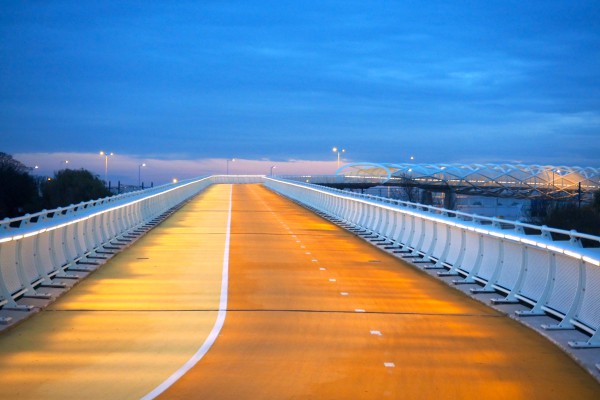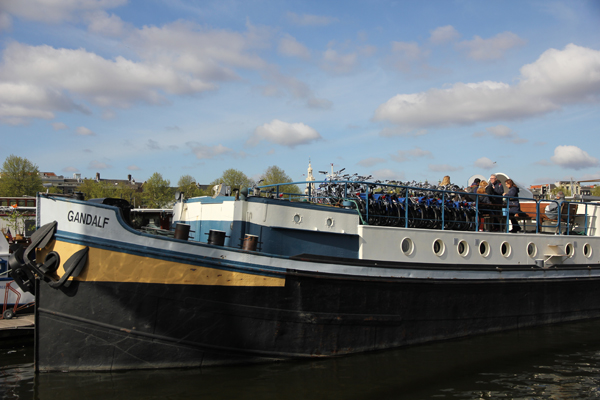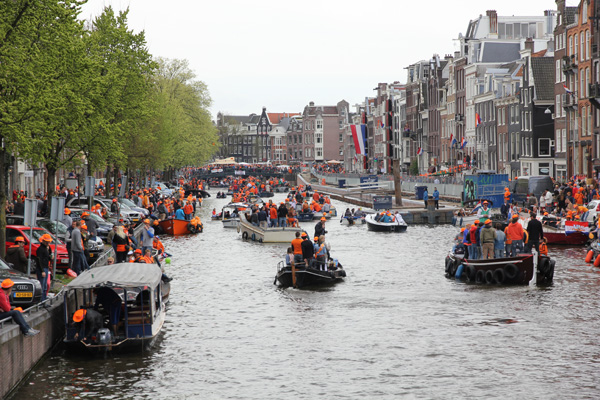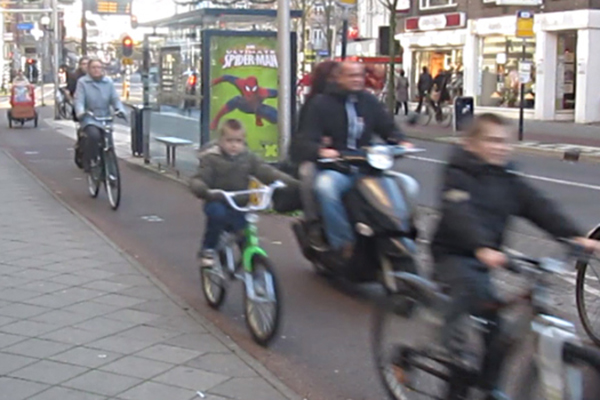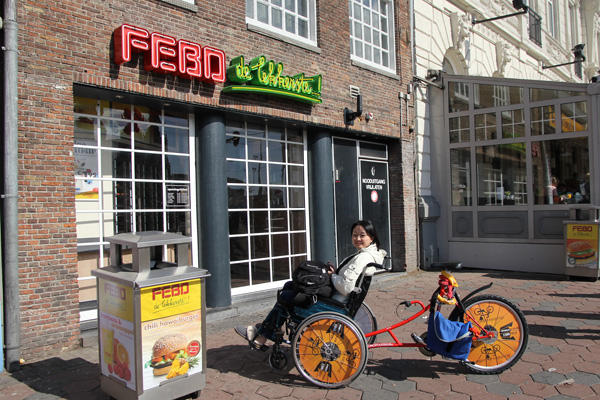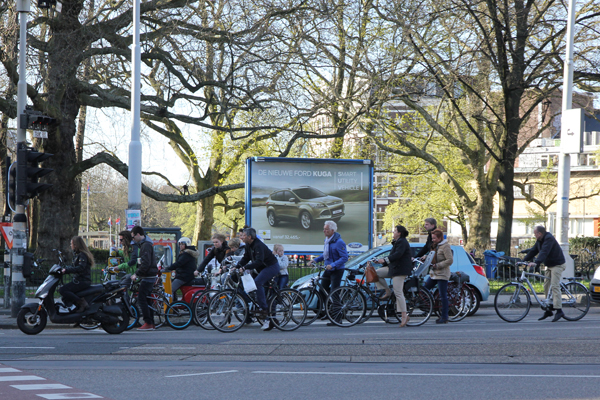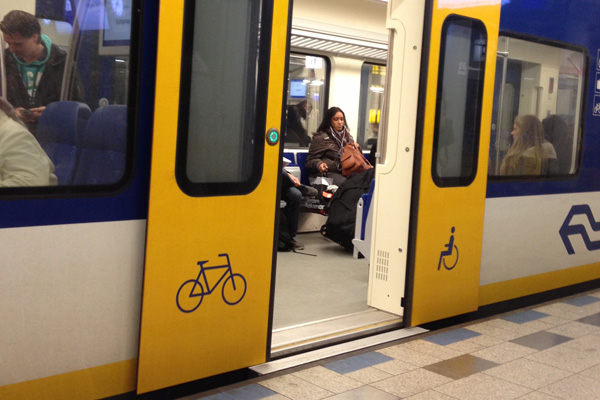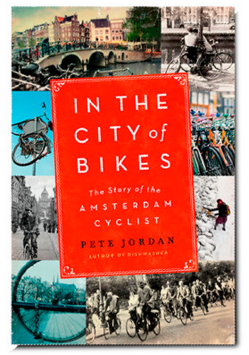Category: Amsterdam – Netherlands
Dutch cycle bridges to live for…
When I am riding on Dutch cycle tracks, I feel wonderful and at the same time a superior sense of dignity you don’t get riding anywhere else. As I mentioned in previous posts (1,2) on “Dutch cycle tracks to die for…”, the paved bike paths are continuous, wide, smooth and “beautifully landscaped”. The “beautifully landscaped” theme is also extended to bridges built for cyclists as well.
The Netherlands probably has the most bridges in the world because of their numerous canals and ditches. And obviously, bridges built specifically for bicycles are a common sight. These bridges are boldly designed and constructed to show appreciation to people biking- at least I’d like to think so. Almost every cycle bridge that was built in the current era that I biked upon is an art piece. When you cycle on some of these bridges, you feel as though you are in a time capsule, while others you feel like you are flying in space. And some are built so that you can enjoy the views of the city. The bridges are built with a slight incline that any unfit person can bike on.
There are also stunning bridges for cars and trains with bike paths on them, but I won’t be talking about them here because I want to point out to you how in the Netherlands, bicycling is just as important as other modes of transportation and this shows in the comparable quality of their bike infrastructure.
The Nesciobrug (Nescio Bridge) is the longest cycle bridge in the country at 779 meters long and was built in 2006 at a cost of 9.5 million euros. The suspension bridge is located in Amsterdam connecting an island suburb of Ijburg to the mainland of the city. This is a bridge you don’t want to miss if you are in Amsterdam. It’s really long and really high up.
The name of this green bridge located north of Nijmegen is accurately called “The Little Green One” or “Het Groentje” in Dutch. It is elegantly designed with an organic delicate look that to me looks like a part of a plant. It’s 120 meters long at a price tag of 4.8 million euros and was completed in 2013. The bridge helps thousands of cyclists cross a busy highway that runs beneath everyday. What’s cool about biking on this bridge is that there’s an elevated cycle track that sits approximately 4 stories high leading to another bridge that connects to “The Little Green One”. The whole experience of riding the whole thing through is quite exhilarating because you are continuously elevated.
What a marvel! A first of its kind! A floating roundabout that keeps cyclists safe away from high volume traffic. It sits on the outskirts of Eindhoven. It is called Hovenring which priced about 20 million euros and was completed in 2012. It looks like a UFO flying saucer and looks even better at night. You can enter the Hovenring from 4 different directions which is so awesome! The track on it is so wide that it can also be a playground or spot to hang out.
You can find this “Green Connection (De Groene Verbinding)” outside of Rotterdam that connects the city to a nature reserve. As you ride through this 190 meter long bridge (opened this year at a finished cost of 9.2 million euros), the shape of the bridge narrows and then widens. You feel as though you are going through a warped tunnel. Also, the LED lights which are connected to sensors come on as you approach the bridge. Very cool!
The photos here don’t capture the complexity of these structures and the experience of riding through them. Bicycle Dutch has wonderful videos on them. The videos about the bridges are below:
1. Nesciobrug, Amsterdam
2. Het Groentje, Nijmegen
3. Hovenring, Eindhoven
4. De Groene Verbinding, Rotterdam
Photo of the Day – Vondelpark in Amsterdam, NL
Photo of the Day – Rijksmuseum in Amsterdam, NL
Book Review: In the City of Bikes by Pete Jordan
The day after coming back from Amsterdam, I was fortunate enough to meet author Pete Jordan at a book reading for his new book In the City of Bikes, a book about bicycling in Amsterdam. He’s an American who went to Amsterdam over a decade ago to study urban development and instantly fell in love with the city and their bicycling culture. So he expatriated there.
It was perfect timing for me to hear about his new book on bicycling in Amsterdam since I just took a trip there and there were a couple of things that I observed that I didn’t understand. Also, I wanted to learn what made Amsterdam the world’s friendliest city for people on bikes. It just boggles my mind that cycling is so prevalent in Amsterdam (and a few other cities) but everywhere else in the world is pretty much dominated by automobiles. While my experience was still fresh in my mind, the book answered my questions and in a wonderful way, it extended my vacation psychologically.
As you can see from the table of contents, there’s over a hundred years (started from the 1890s) worth of bicycle history in Amsterdam. The book has in-depth quotations, facts, and details for almost every important decade chronologically.
In the City of Bikes also reads like a personal memoir which I really enjoyed reading. One example is when his wife, Amy Joy becomes a bicycle mechanic and subsequently starts a bike shop. Another example is the bonding between father and son when his son Ferris sits in front of him on a bicycle playing the game Which Way?.
Mostly, the book speaks about the rich historical culture of bicycles in Amsterdam and it’s engaging. Amsterdammers had fought for their ways against anti-cyclists, Nazi occupation and confiscation of their bikes, and rampant thievery. Through it all, they still tried to implement the White Bicycles Plan in the 1960s which has inspired today’s bike-share programs around the world just as much as their utopian bicycle infrastructure.
The author also covers the story about the famous and controversial Rijksmuseum bike passageway which was recently reopened to cyclists after a decade of closure and was breaking news in the city.
If you are interested in cycling and Amsterdam cycling, both historically and culturally, then this book is for you!
One thing I would like the author to elaborate a little more on is to have more emphasis on his personal experience as an American foreigner moving to Amsterdam for the bicycle culture and also so I can relate even more closely to his passion for bicycling. Perhaps he’s saving it for his next book? I hope so.
Pete Jordan is also the author of the memoir Dishwasher: One Man’s Quest to Wash Dishes in All Fifty States.
HarperCollins Publishers, 2013, $15.99 USD.
Related post:
2 Wheels and A Bad Foot in Amsterdam – Part 3
In parts 1 and 2 of our series on Amsterdam, we had a wheelchair bike as our vehicle of transport. After pedaling Nellie around on it for a few days, I realized that it wouldn’t be good for very long distance trips since it can get very tiring. So, we also rented an electric-assisted Bakfiets cargo bike thinking that it would be better, but realized that the power still wasn’t enough to go a long distance with an adult sitting inside. Furthermore, as you can see in the image below, the depth of the seating area is too short for an adult to sit on comfortably. I was planning on using it to go 22 miles (35 km) one way to Keukenhof Tulip Park which is about a 2 hours ride (in my case, it’s probably 3 hours), but I chickened out. Either I will become too exhausted or Nellie’s butt would be in flames, so I didn’t want to take that chance. So we had to sell out on our bike experience and rent a car just for that day.

Electric-assisted Bakfiets was too heavy for a long distance ride and has an uncomfortable seating area for an adult.
The reason why we entertained the idea of riding all the way out to the Keukenhof Tulip Park in the first place was that we had a positive experience when we we rode out to Zaanse Schans to see some Dutch windmills the other day. It was such a great experience getting out of the busy city center where the wheelchair bike was rolling on bumpy paved roads and transitioning to smooth paved roads in open and modern spaces.
When we left the city center, wow, it was bike utopia! Although we were still within the periphery of Amsterdam city, we were no longer in the old city core. The roads were smooth and separated bike paths went in every direction you would need or want to go. Amsterdam is indeed number one in bike infrastructure along with many other Dutch cities. If you want great infrastructure for cycling, one should look to the Dutch for the model. I have been to a handful of bike-friendly cities, and none of them come close to Amsterdam. The cycle tracks are very wide with wide buffers from the streets, and stretch continuously for miles, and you can get from point A to B and C without feeling unsafe. Traffic signs/signals for bicycles are everywhere and I felt that the priority of bicyclists exceeds that of motorists. Every time I was at a red traffic signal for bicycles and a button was there for me to press, it wasn’t long before the light turned green for me. One thing I noticed about how they did auto traffic calming was that on streets that have two lanes, where they become one lane, the left lane merges into the “slower” right lane. This slows traffic down as opposed to the States where cars in right lanes usually have to merge into the “faster” left lane.
The paths and sidewalks were very wide with larger brick tiles which reduced the bumpiness when rolling over them making it much more comfortable for Nellie on the wheelchair bike. The larger brick tiles alternate with large sections of smooth pavement. The paths are so wide that you can ride at least 2 abreast. This allows for conversational cycling (having a conversation with a companion while riding your bikes side by side) which makes cycling even more enjoyable. Some streets have two cycle tracks that are bi-directional. Pretty crazy, huh? How can any street that has two cycle tracks also have two way traffic? Well, just reduce car usage by increasing bike usage, so you have more room for cycle paths. Voila!
Notice the red pavement in the photo below- that is colored asphalt, not just asphalt that has been painted like what we have in San Francisco. Because it is colored asphalt instead of paint on asphalt, it is less slippery during the wet season unlike the slippery green paint on our SF bikeways.
We saw tiny vehicles such as the Canta LX that are allowed on the cycle tracks and are small enough to legally park on sidewalks (I don’t even think you need a driver’s license to drive one!). They aren’t actually cars but are more like covered scooters. They can go up to 28 mph (45 km/h) and a folded wheelchair can fit in the rear. They are great for the elderly and disabled. We may rent this next time so Nellie can finally take control of the wheels. =) We also saw a handful of mobility assisted scooters on the cycle tracks as well.

Driver in the Canta car dropping off her child. Notice that it is on the cycle track and not in the street.
With 25% of the Netherlands below sea level, it just makes sense to have bikes on boats too (see photo below)- or the Dutch just really like bikes. Is it a bike tour or boat tour? Hmm…
When we got even further out and left the city altogether, I pedaled Nellie on the wheelchair bike on this beautiful separated bike path for 14 uninterrupted miles (23 km). Well, the journey was almost uninterrupted except at one point where we took a ferry to the other side (the ferry was absolutely free!). The wide separation between the cycle tracks and streets made cycling peaceful and you were away from car exhausts. The paths were lined with trees for much of the way which added to the serene experience. That is how riding a bike should be. It was the best riding experience I ever had in my cycling career even considering I was riding on a wheelchair bike. Nellie even said that she didn’t think about her injured foot for a moment.

Wide and smooth pavement stretches for miles. Notice the wide buffer between street and cycle track.
On the way to Zaanse Schans, it was breathtaking to see these wind turbines on the sides of the cycle track. One of the main reasons why I ride is because of environmental reasons so those wind turbines really stood out to me and affected me on a personal level. We also saw many performance cyclists in their spandex and gears. It must be awesome to ride fast for hours on these very long, and “open road” bikeways.
On our last full day in Amsterdam, it was Queen’s Day. For most people, as a visitor or even a local, it’s wonderful to experience Queen’s Day. This Queen’s Day was especially important because Queen Beatrix abdicated her throne for her son, now King Willem-Alexander. The local population of Amsterdam is around 820,000 and on the days leading up to Queen’s Day, the population typically doubles with all the celebrators. Most of the population congregates in the city center. The entire city center is generally closed off to traffic on that particular day. So you can imagine that it was very crowded. Nellie decided to stay in for that day knowing that maneuvering for her would be very difficult, but I got out and about to observe some Dutch culture. I didn’t know that the Dutch were such partiers and loved their Queen.

Here was this girl and her father dressed for Queen’s Day. She looked very comfortable. Orange is the color of the Dutch royal family.
With 800,000 more visitors coming into the city, of course the city is already prepared to accomodate all these bikes. The ample space from the dozens of water canals makes a good place for bike parking. There were three of these boats filled with bikes on this one canal I saw. Bicycles rule in Amsterdam!
To conclude our Amsterdam trip, it was just too difficult to maneuver around in the city center on a wheelchair bike especially during a crowded holiday. I can imagine it would be nice for those on regular bikes though because of all the historic buildings, canals, and scenery. We did enjoy every bit of the experience when we left the city center. Overall, riding a bike in the Netherlands is truly a joyful cycling experience and I could understand if anyone expatriated to the Netherlands solely for bicycling. I know of a couple of people who did.
Thank you to the Netherlands from the bottom of every cyclist’s heart for making it a great bicycling country for all of us to see and try to emulate and showing that a society built around bicycles can be achieved.
Related posts:
2 Wheels and A Bad Foot in Amsterdam – Part 2
2 Wheels and A Bad Foot in Amsterdam – Part 1
The Netherlands in 30 Photos – What you’ll see if you ride a bike in the Netherlands
2 Wheels and A Bad Foot in Amsterdam – Part 2

A water canal filled with swans. How many swans can you count in this picture? Answer at the bottom of this post.
The primary way of getting around Amsterdam for Nellie was not her own two feet but our trusty wheelchair bike from StarBikes Rental as discussed in an earlier post. The wheelchair bike was very helpful, but there were two issues we had with it.
The first issue was that the ride was bumpy and uncomfortable for Nellie on the brick paved roads which are ubiquitous in Amsterdam’s old city center. She could feel every little bump and irregularly in the ground as we rolled along and because her foot was already sensitive, the shaking and sudden jerks would hurt her foot. Whenever we hit a bump or dip, she had to be sure to lift her foot in time so as to soften the impact, but it was still unpleasant and tiresome for her. I had to ride very slowly and carefully trying to avoid potential problem areas. The rocky ride could’ve been due in large part to the skinniness of the wheelchair tires. I think they should have used fat tires for the wheels like those seen on Dutch bikes to better absorb shocks. The bumpiness may not be such a big issue for other wheelchair bike users if they don’t have any aches and pains on their body and can tolerate a little shaking.
The second issue was that when it rained, Nellie’s legs and feet got wet. The wheels do not have fenders and it is hard to cover the legs and feet when it rains. Nellie used an umbrella but it didn’t reach her legs and the umbrella kind of blocked my view as I was pedaling. Also, my legs would have gotten wet too if I hadn’t worn rain pants. If you’re going to use a wheelchair bike when there is a good chance of rain, which the Netherlands has plenty of, be sure the wheelchair rider is at least wearing waterproof footwear and waterproof pants. It can get pretty cold once the pants get wet. There is also a waterproof cover for the legs that comes with the wheelchair bike but we didn’t bring it with us. It didn’t look inviting to us to use it for some reason.
Amsterdam’s old city center is not made for people with a disability, particularly people with limited mobility. We stayed in Nieuwmarkt square in the city center which is about 800 years old. When a place is that old, the buildings and its infrastructure are not going to be conducive for people on wheelchairs. Apparently, wheelchairs didn’t exist back then and of course, the Dutch have done a good job in preserving the original historic look of the place. So, the town has narrow sidewalks which often get crowded and force people to walk in the streets (see photo below). Also, shops and stores have very narrow doorways that wheelchairs can’t fit through and often have steps instead of a ramp. The small brick pavement on both the streets and sidewalks makes it harder to roll a wheelchair around.
Not only are the sidewalks too narrow to push a wheelchair on, but you also have bicycles, scooters and even cars parking on them creating a veritable obstacle course. If you take the narrow street which only fits one car’s width, you would have to maneuver to the side whenever cars drive through which happens occasionally. Rolling a wheelchair back onto the sidewalk is difficult because on-ramp curbs are not placed throughout. There are some streets that are level with the sidewalk but they are not that common. I think Amsterdam’s urban planning officials should look into restricting private car access (taxis and delivery vehicles are okay) into these small city center streets using a filtered permeability design like how Strasbourg in France has in their city center. I did see that they restricted car access on some streets at certain times of the day but I don’t think that’s enough. Not only is this better for wheelchair users, but it creates a less chaotic environment for regular bicyclists and pedestrians which crowd the city center. Closing down the old city center to cars is actually a very common thing many European cities do which Amsterdam surprisingly has not done.
In addition, we noticed gas-powered mopeds using the same cycle tracks as bikes. They are fast, loud, and smelly and we didn’t like them one bit. We thought they were quite menacing and have heard that there are many locals who think so too. Many of them seemed to be going faster than the 20 mph (30 km/h) posted speed limit and we’ve heard that many of them have had their speed restrictor removed. Not only do they speed but they also make a loud racket and from their 2 stroke engines, leave a plume of noxious and unpleasant fumes in their wake. Often one would come zooming by suddenly and it would scare the bejesus out of Nellie, she almost got up and started walking. In the States, we have to deal with absurd and narrow bike lanes (or the lack thereof) that bring us in closer proximity to fast moving cars and plentiful opportunities for car-dooring. So I know that as a cyclist, I would definitely get annoyed by them if they were riding on cycle tracks here. According to Bicycle Dutch, there has been an increase by 3 fold in the number of mopeds on cycle tracks in the past five years in Amsterdam and 94% of them speed. I heard from Pete Jordan and Amsterdamize that Amsterdam is working on legislation to ban mopeds from cycle tracks.
So far, it probably sounds like the bike ride in the city center was a lot of trouble especially for Nellie, but there were many positive highlights. One thing which brought a smile to Nellie’s face was enjoying some goodies from the Dutch fast food chain FEBO. We recognized FEBO from Anthony Bourdain’s Layover show, so we decided to give it a try. They make great biking food because of their convenient grab and go vending machines. You simply walk up to the food of your choice displayed inside the vending machine, insert your coins into the slot, and then open the door and grab your food. Despite it being a fast food chain, the quality of their food was actually pretty good and blows McDonald’s away. They have all these hot and tasty croquettes filled with different stuffings like beef and curry, burgers and chicken sandwiches. They were delicious. No cashier to deal with. Just your hungry stomach and the machine. It was one of our most favorite things to eat there.
Another thing we noticed on a positive note was that there was a certain fluidity to the way cyclists, pedestrians, and motorists maneuver around each other at intersections within the city center. See the video below. We observed that there were no stop signs so everyone whether they were in a car, on foot, or on bike would yield to one another and they had to share the road. They did all this without making a fuss. This sort of set up would never happen in the States. If you were to ride on the sidewalk, pedestrians would bark at you. If you were to ride in the car lane, motorists would honk at you to get off the road. But in Amsterdam, I noticed that this system of common sense and courtesy between pedestrians, cyclists and motorists actually seems to work. This civil behavior is probably a result of the understanding they have for one another because they all have experience riding bikes as a means of transport.
Now I want to talk about how wonderful the cycling experience is outside of the town center. Even though it was a challenge biking with the wheelchair bike in the middle of old Amsterdam, biking outside the city center was utopia. In the city center, the streets and buildings are historic and like I mentioned earlier, the streets there are not so conducive for wheelchairs. Not only are they paved with bricks but they are also congested, filled with tourists (lots of tourists because it was just days before Queen’s Day, a huge national holiday and the historic abdication of Queen Beatrix), and the area can get pretty chaotic. But when you go further out, you find that the spaces open up and become more organized. That is where the true quality of the cycling infrastructure in Amsterdam becomes apparent.
How great is the cycling infrastructure in Amsterdam you might ask? Just look at the photos below. I randomly took this photo and to my surprise I caught every gender and age group in one shot at a traffic signal. That is a sign that the cycling there is comfortable for everybody, ages 8 to 80.
Cycling on Amsterdam’s paths are so safe that a mom, dad and child are not wearing helmets and riding together on a single bike. How delightful is that?!
Because the cycle tracks are away from cars, this man can take his time riding his heavy workcycle.
I will end here about our wheelchair-biking experience within Amsterdam and will cover more of our experience when we journeyed outside of Amsterdam city in our next post. Stay tuned!
Answer to the question at the beginning of the post: 13 swans!
Related posts:
2 Wheels and A Bad Foot in Amsterdam – Part 1
2 Wheels and A Bad Foot in Amsterdam – Part 3
The Netherlands in 30 Photos – What you’ll see if you ride a bike in the Netherlands
The Netherlands in 30 Photos
Some of the things you will see if you ride a bike in the Netherlands…
 |
 |
 |
 |
 |
 |
 |
 |
 |
 |
 |
 |
 |
 |
 |
 |
 |
 |
 |
 |
 |
 |
 |
 |
 |
 |
 |
 |
 |
 |
Photos were taken in Amsterdam, Zaandam, Zaanse Schans, and the Keukenhof Tulip Park.
See more:
Two Wheels and A Bad Foot in Amsterdam – Part 1
Two Wheels and A Bad Foot in Amsterdam – Part 2
Two Wheels and A Bad Foot in Amsterdam – Part 3
In the City of Bikes (Amsterdam) By Pete Jordan Book Reading
2 Wheels and A Bad Foot in Amsterdam – Part 1
In a previous post, we were going full steam ahead with our plans to travel to the bicycling capital of the world, Amsterdam, even though Nellie had injured her foot and was unable to bike or walk very much. We were encouraged by videos that we had seen by Bicycle Dutch about how the bike infrastructure in the Netherlands also benefits disabled people by making it easier for them to get around and by the fact that we could rent a bike with a wheelchair attached to the front.
Amsterdam is the world leader in bicycle infrastructure- they have more bikes than people at about 1.5 bikes per person and the percentage of trips made by bicycle is between 50-60%. We were interested in experiencing and seeing this city of bikes for ourselves, with two wheels (the wheelchair bike actually had three) and a bad foot.
We arrived at Schiphol airport in Amsterdam in the early morning hours on a Thursday, and we were able to directly board a train to Amsterdam Central station which is located in the heart of Amsterdam. We were able to take the airport’s complimentary wheelchair all the way down to the train platform.
Taking a train is a lot cheaper than taking a taxi. The train into Amsterdam Central only costs 4 euros per person as opposed to 35-40 euros for a cab.
The photo below shows this unbelievably huge bike parking station that we saw right outside of Amsterdam Central station. It is probably Amsterdam’s most famous bike parking station as it is featured in a lot of photos and media online. Even though it was as big as a small multi-level car parking garage, it still didn’t have enough room to hold all those bicycles. Thousands of parked bikes were lined against bridge railings, on sidewalks and in other parking stations nearby. The locals are probably used to it but as an outsider, being there was surreal and we even saw other visitors taking their own photos and videos of it.
The first thing we had to do when we arrived at Amsterdam Central was pick up a wheelchair bike. We had one reserved two weeks in advance at StarBikes Rental.
However, when we arrived at Amsterdam Central, things didn’t go to our expectations. The train station was larger than we had imagined and it was really difficult for Nellie to walk the distance to exit the station. It would have helped if the train station loaned out wheelchairs but I didn’t think about it at the time. Nellie had her orthopedic walking boot on so she was able to make it outside the station with some effort. She sat at an outdoor table near a Subway sandwich shop while I immediately went to StarBikes Rental to get the wheelchair bike, a good 10 minutes walk from the station. We had to hurry because we had an appointment to meet the apartment manager where we were staying to get the room key.
The wheelchair bike was $32 USD (25 euros) for a 24 hours rental and it came with a heavy blanket to keep the wheelchair rider’s legs and body warm. It had three speeds which is plenty enough for Netherlands’ flat topography and backpedals to brake.
Then I realized that it was next to impossible to haul two luggages (both attached to each other) and pedal Nellie on the wheelchair bike to our apartment. I had to make two trips, first walking with the luggage to the apartment to meet the manager, drop off the luggage, go through orientation, and get the room key. Then back to pick up Nellie and pedal her to the apartment. Luckily, it was not very far from the station but it was a huge time-wasting ordeal and Nellie had to wait outside the train station with the wheelchair bike in the cold for me for over an hour.
If you plan on traveling to Amsterdam with people with limited mobility, I recommend hiring a cab to get to your hotel first to unload your luggage instead of trying to do what we did, especially if you are unfamiliar with the area. Then once settled, go to pick up the wheelchair bike if you want to use one.
Also, if you plan on staying in an apartment instead of a hotel, make sure it has an elevator or consider staying in a hotel instead. Most of the apartments in Amsterdam are in old houses which do not have elevators. Our apartment didn’t have one but had three flights of stairs Nellie had to climb up.
After we settled into our apartment, Nellie was able to rest her foot since it got very swollen. We rested until we were ready to venture out again, plus the jet lag was kicking in hard and we fell asleep.
It was an overcast Friday morning when we headed out on the wheelchair bike for the first time. We headed across town to the Rijksmuseum, a famous museum in Amsterdam. We approached the backside of the museum and when we got there we saw that the bike passageway under the museum to get to the other side was barricaded off to cyclists. The guards turned away a woman trying to ride through so instead of going straight, we went around the block to reach the other side. When we got there, we noticed a group of people on bikes were somehow able to ride through the Rijksmuseum passageway and they passed right in front of us. They seemed pretty happy and excited and some of them were cheering. We had no idea what was going on and were confused but thought nothing further of it.

It is hard to see in this photo, but the Rijksmuseum bike passageway through the arches was blocked by barricades.
Later by chance, we found out what took place that morning via the tweets of @BicycleDutch and @Amsterdamized. At first, I didn’t make the connection between what I saw that morning with the discussion on Twitter, but then when I watched the video that @BicycleDutch linked, it all clicked for me.
You can watch the video here.
Thanks to @Amsterdamized, I later found out more of the background story of what happened that morning and why: The long-existing bicycle passageway under the Rijksmuseum had been closed for a good 10 years for the rennovation of the museum. However, having bikes go through there did not fit the vision of the museum director who used his powers to try to permanently close the bike path. Thankfully in the end, there was a vote and the director lost. The re-opening of the bike path was then stalled to May 14th because according to the director, there would be mayhem and that they need time to prepare precautions. That morning, a few cyclists in Amsterdam were tired of waiting for it to re-open and decided to partake in some good old civil disobedience.

On the other side of the museum- I happened to take a photo either just before or after the group of protestors rode through. I think this guy was at the way front or end of the pack.
I chuckle thinking about what would have happened if we had arrived at the museum 15 minutes later than we did. We would have arrived when the group of protestors rode through. We might have been caught up in the group and seeing them go through we might have thought the passageway was open and tried riding through ourselves. I saw in the video that one of the riders at the back, a lady on a folding bike, got knocked down by the guards. Who knows- maybe we could have been the ones getting knocked down- although who has the audacity to knock down a person in a wheelchair (bike)? It would’ve been quite a moment for us wondering why the heck we got knocked down by some Dutch people. “Is it because we are Americans?!” Then finding out we were inadvertently part of a little bike history in Amsterdam, I would have been like, “Cool!”
What I learned from that act of civil disobedience by a bunch of ordinary civilians is that despite Amsterdam being the bike capital of the world and long having bicycles be a part of their history and culture, they still have to advocate for biking and bike infrastructure there. I naively assumed beforehand, that unlike here in San Francisco, almost everyone was on the same page about biking there, and that just about any bike project would get off the ground with hardly a peep against it. The fact that the Rijksmuseum director would try to stop this bike path from re-opening despite it being there since 100 years ago was unthinkable to me.
I realize now that advocating for bicycle infrastructure and cyclist’s rights is something that will never end no matter where a city is in the world or where they sit on the Copenhagenize Index.
Update on the Rijksmuseum bike passage: It’s now open! Congrats Amsterdam! Read more about it at the links below!
Hundreds of Bicyclists Pour Through Dutch Museum
Video: First ride through – Fietstunnel weer open!
Stay tuned for the next post in the series, Two Wheels and A Bad Foot in Amsterdam where we share in more detail, our experience biking in Amsterdam’s busy city center in the days leading up to Queen’s Day, a huge national holiday in Netherlands. We’ll also show you the wheelchair bike modeled by Nellie herself.
Related reading:
2 Wheels and A Bad Foot in Amsterdam – Part 2
2 Wheels and A Bad Foot in Amsterdam – Part 3
The Netherlands in 30 Photos – Some of the things you will see if you ride a bike in the Netherlands
In the City of Bikes by Pete Jordan Book Reading
We are halfway through our Amsterdam experience (with two wheels and a bad foot) and we already have so much to share with you guys that we have not tweeted about. But in the meantime, if you want to learn more about the history of bike culture in Amsterdam, there is going to be a book reading for “In the City of Bikes” by Pete Jordan on May 2nd in San Francisco. Pete Jordan contacted us about it and we think it is definitely worth checking out! More details below!
Hey there,
This is Pete Jordan, author of the book “In the City of Bikes.” Thanks for giving my book a mention a couple weeks ago on your site. I see you’re in Amsterdam now while, coincidentally, I’m leaving soon for San Francisco (where I was born and raised). I’ll be reading from my book on Thursday, May 2nd at Needles & Pens, 3253 16th St., 7 p.m. If you can give my reading a mention on your site, I’d really appreciate it!
Thanks and take care,
Pete
www.cityofbikes.com
If you won’t be in SF on May 2nd, there are other upcoming dates and locations all around the US and also Netherlands. Check here for more.
Book Description from Amazon.com:
Pete Jordan, author of the wildly popular Dishwasher: One Man’s Quest to Wash Dishes in All Fifty States, is back with a memoir that tells the story of his love affair with Amsterdam, the city of bikes, all the while unfolding an unknown history of the city’s cycling, from the craze of the 1890s, through the Nazi occupation, to the bike-centric culture adored by the world today.
Pete never planned to stay long in Amsterdam, just a semester. But he quickly falls in love with the city and soon his wife, Amy Joy, joins him. Together they explore every inch of their new home on two wheels, their rides a respite from the struggles that come with starting a new life in a new country.
Weaving together personal anecdotes and details of the role that cycling has played throughout Dutch history, Pete Jordan’s In the City of Bikes: The Story of the Amsterdam Cyclist is a poignant and entertaining read.
Related reading:
Bicycle Travel – Amsterdam
Hello readers,
About five months ago, Nellie and I had started planning for a trip to Amsterdam to see and experience the best bicycling city in the world for ourselves. We were planning on bringing our Brompton folding bikes with us and decided to have the courage to gate-check them this time (rather than transporting them in checked luggage) at the airport. But anything could happen in five months and indeed something did happen.
Unfortunately, Nellie injured her left foot about three weeks ago and each day that has passed hasn’t brought much improvement. She hasn’t been able to walk normally and when she does have to, she hobbles along with difficulty or she puts on an orthotic boot and uses crutches.
The days are quickly winding down until the day we are to fly out for Amsterdam so we initially thought about canceling the trip. “Nooooooo!”, was what went through my head. “Our opportunity to have the best cycling experience ever and now this is happening to us?”
Then we thought about how the cycling infrastructure is so wonderful in the Netherlands that people with disabilities are benefiting from them and getting around easily as well. So from that we decided that we could still take this trip.
First, we thought about how we could transport ourselves since Nellie cannot ride a bike or walk very much. “Cargo bike!”, we thought. We were excited at that idea since Nellie can just ride inside the cargo box while I pedal. But if we were to go to a museum or somewhere bikes are not allowed to enter, it would be a problem since Nellie can’t walk a good distance before she needs a rest and walking with crutches can get very tiring. We could request a wheelchair at the museum, but we may not always be able to get one at other places.
Then, I remembered seeing a wheelchair bike in this great video (1:14) by Bicycle Dutch. I could see myself riding it everywhere pedaling while Nellie sits on the wheelchair that is attached to the front. And did I say that the wheelchair is detachable? So that means that we can park the bike and detach the wheelchair to go inside museums and other places. How brilliant is that?! I found a bike rental shop called StarBikes Rental Amsterdam behind the Amsterdam Central train station that rents out wheelchair bikes. I quickly reserved it and we are going full steam ahead. Yes!
While we are hoping for her foot to be better by the time we leave for Amsterdam (she will eventually get better, just not in time for the trip), this experience will be interesting to see how accommodating Amsterdam will be for bicycles and people with limited mobility. From what I have learned from Bicycle Dutch’s blog, I expect that it will be a positive experience. Plus, I will still have a blast pedaling all around Amsterdam and the Netherlands with Nellie right beside me.
So, we are going to take off for Amsterdam soon and plan on sharing what we will learn with you in some future posts. While we are there, we will not post anything to this blog. But we will be actively tweeting about our observations on biking there and how Nellie is able to get around as a disabled person in Amsterdam.
You can follow our live tweets of our bicycling adventure in Amsterdam at our Twitter page here starting on April 24.
Thanks and happy pedaling even if you have a bad foot!
Update: We’re back! Read how things went in our series on Amsterdam:
Two Wheels and A Bad Foot in Amsterdam – Part 1
The Netherlands in 30 Photos – Some of the things you will see if you ride a bike in the Netherlands






